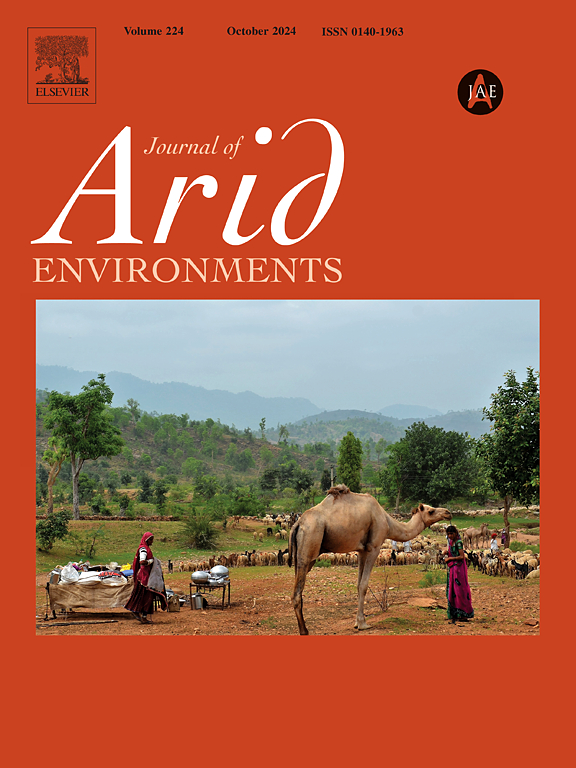温带沙漠生态系统中一年生植物和瞬生植物在不同生长阶段对无机氮和有机氮的偏好
IF 2.5
3区 环境科学与生态学
Q2 ECOLOGY
引用次数: 0
摘要
为了利用陆地生态系统中有限的氮(N),不同类型的植物可能会采用不同的氮吸收策略,以避免和减少对资源的竞争,从而完成其生命周期。研究沙漠生态系统中不同类型植物对氮的利用是否存在生态位分离,有助于深入了解沙漠植物的生存策略,更好地理解氮对其生存的影响。Centaurea pulchella、Lactuca undulata(均为昙花一现的植物)、Ceratocarpus arenarius和Suaeda glauca(均为一年生植物)是中国西北部古尔班通古特沙漠中广泛分布的四种植物。我们采用 15N 标记技术对这两种植物在不同月份和不同土层中对不同形式氮的吸收策略进行了野外试验研究。结果表明,在不同土层深度,两种植物最大生物量期的氮吸收率均高于最快生长期。虽然四种植物都能吸收各种常见形式的氮,但无机氮仍是它们吸收氮的主要形式。昙花一现的植物更喜欢吸收硝酸盐,吸收率最高,达到 5.74 μg h-1。不过,一年生植物更喜欢吸收铵,最高吸收率为 4.74 μg h-1。从不同氮形态对总氮吸收的贡献率来看,硝酸盐是对昙花一现植物最有利的氮形态(贡献率为 36.98%-48.13%),而铵盐是对一年生植物最有利的氮形态,最高和最低贡献率分别为 48.3%和 30.47%。此外,影响植物对不同形式 15N 的偏好的关键因素不是植物的生长特性,而是月份、土壤深度和植物生命形态等因素。研究表明,在古尔班通古特沙漠中,昙花一现的沙漠植物和一年生植物在氮的利用和恢复方面表现出多样性,它们也都能吸收可溶性有机氮源。我们的研究有助于更好地了解沙漠生态系统中不同植物物种在氮约束下对养分利用的可塑性。本文章由计算机程序翻译,如有差异,请以英文原文为准。
Preferences of annual and ephemeral plants for inorganic N versus organic N at different growth stages in a temperate desert ecosystem
To utilize limited nitrogen (N) in terrestrial ecosystems, different plant types may employ different N uptake strategies to avoid and reduce competition for resources and thus complete their life cycles. It is helpful to study whether there is niche separation in the use of N by different plant types in desert ecosystems, for gaining insights into the survival strategies of desert plants and for better understanding the effects of N on their survival. Centaurea pulchella, Lactuca undulata (both ephemeral plants), Ceratocarpus arenarius, and Suaeda glauca (both annual plants) are four widely distributed plant species in the Gurbantunggut Desert in northwest China. We conducted an experimental field study employing the 15N labeling technique to study the uptake strategy of different N forms by these two types of plants in different months and different soil layers. The results indicated that the N uptake rates during the maximum biomass period of the two plant types were higher than those during the fastest growth period in different soil depths. Although all four plants could absorb various common forms of N, inorganic N was still the major form of N absorbed by them. Ephemeral plants preferred to absorb nitrate, with the highest uptake rate reaching 5.74 μg h−1. However, annual plants preferred to absorb ammonium at a maximum uptake rate of 4.74 μg h−1. According to the contribution rate of different N forms to total N uptake, nitrate was the most favorable form for ephemeral plants (contribution rate 36.98%–48.13%), whereas ammonium was the most favorable form for annual plants with the highest and lowest contribution rates of 48.3% and 30.47%, respectively. Furthermore, rather than the plants’ growth characteristics, factors such as month, soil depth, and plant life-form were the key drivers influencing the preferences for different forms of 15N. The research revealed that ephemeral and annual desert plants exhibit diversity in their utilization and recovery of N, and all of them could also absorb the soluble organic N source in the Gurbantunggut Desert. Our study contributed to a better understanding of plasticity of nutrient utilization by different plant species under N constraints in desert ecosystems.
求助全文
通过发布文献求助,成功后即可免费获取论文全文。
去求助
来源期刊

Journal of Arid Environments
环境科学-环境科学
CiteScore
5.70
自引率
3.70%
发文量
144
审稿时长
55 days
期刊介绍:
The Journal of Arid Environments is an international journal publishing original scientific and technical research articles on physical, biological and cultural aspects of arid, semi-arid, and desert environments. As a forum of multi-disciplinary and interdisciplinary dialogue it addresses research on all aspects of arid environments and their past, present and future use.
 求助内容:
求助内容: 应助结果提醒方式:
应助结果提醒方式:


